Monday Apr 07, 2025
Monday Apr 07, 2025
Friday, 10 January 2025 00:28 - - {{hitsCtrl.values.hits}}
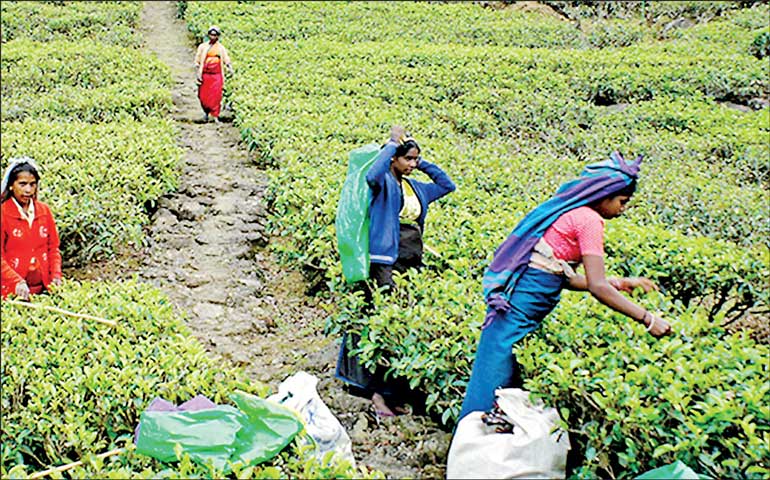
That this unfortunate community was criminally exploited for hundreds of years by British and then Ceylonese, as well as Sri Lankan plantation companies later, is a public secret; as is the fact that these Tamils were discriminated against by colonial and native governments
 As the Hindus of Sri Lanka mark Thai Pongal this week, it would be of interest to examine the nexus between those who celebrate the multi-day harvest festival, others who don’t, and their common as well as disparate histories harking back to colonial times.
As the Hindus of Sri Lanka mark Thai Pongal this week, it would be of interest to examine the nexus between those who celebrate the multi-day harvest festival, others who don’t, and their common as well as disparate histories harking back to colonial times.
Ergo, a two part piece that focuses on the tale of one of these two ethnicities and the skein of history weaving them both into what is often perceived as a single community.
The upcountry Tamils of Sri Lanka constitute an interesting case study in terms of their historical origin, socio-cultural development or ostensible absence thereof, and contribution to the political life of the island nation-state.
From their Indian origins to the chequered quest for citizenship in either Sri Lanka or India, an examination of the past provides insights into the colonial, ethnic, sovereign state, local party political, caste, class and humanitarian dimensions of their struggle.
Around two centuries ago, hundreds of thousands of indentured labourers of Indian origin arrived in Sri Lanka, and journeyed on foot from the island’s north-western shores to its central and southern hills, fated to work on the then British Empire’s tea, coffee and rubber plantations.
Today, although the colonial era is more than 76 years past, these ethnic Tamils remain “one of the most marginalised communities in Sri Lanka” (Vandana Menon, ‘200 years of Indian Tamils in Sri Lanka’, The Print, 2 November 2023).
Ferried over from India by the British Raj, these ‘Malaiyaha’ or hill-country Tamils were subjected to a litany of injustices – from being denied their rights of citizenship to labouring unrewarded on tea and other plantations under egregious conditions.
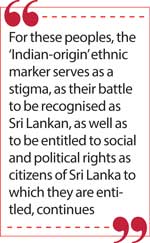 The bitter dregs of history
The bitter dregs of history
A media report in The Print of 2 Nov 2023 captured the status of these people: “The history of Sri Lankan tea plantations and its workers is tied to the ethnic make-up of the island nation – and the upcountry Tamils are at the bottom of the totem pole. The community is a distinct ethnic group, constituting the fourth-largest population in the island nation following the Sinhalese, the ‘Sri Lankan’ Tamils and the Muslim community.”
These upcountry Tamils are socially, politically, and culturally separate from the Tamil communities in the north and east of Sri Lanka, who have a “much longer and more complex history” (Menon, The Print, 2 Nov 2023).
That this unfortunate community was criminally exploited for hundreds of years by British and then Ceylonese, as well as Sri Lankan plantation companies later, is a public secret; as is the fact that these Tamils were discriminated against by colonial and native governments.
For instance, Ceylon’s Citizenship Act of 1948 “stripped the community of its citizenship, making its members stateless” (Menon, The Print, 2 Nov 2023). As Indian journal The Print summarises:
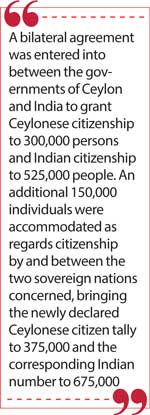 “The Sirima-Shastri Pact, signed in 1964 between Prime Ministers Sirimavo Bandaranaike and Lal Bahadur Shastri, repatriated at least 500,000 Indian-origin Tamils to India. But those who remained behind in Sri Lanka had to struggle for rights up to 2003, after having being granted tenuous citizenship in 1977.”
“The Sirima-Shastri Pact, signed in 1964 between Prime Ministers Sirimavo Bandaranaike and Lal Bahadur Shastri, repatriated at least 500,000 Indian-origin Tamils to India. But those who remained behind in Sri Lanka had to struggle for rights up to 2003, after having being granted tenuous citizenship in 1977.”
For these peoples, the ‘Indian-origin’ ethnic marker serves as a stigma, as their battle to be recognised as Sri Lankan, as well as to be entitled to social and political rights as citizens of Sri Lanka to which they are entitled, continues.
Recently, the Indian Ocean regional press spotlight focused on this Indian-origin community, as a series of events commemorated the arrival of these Malaiyaha Tamils’ ancestors in the isle. At the end of 2023, a representative group symbolically marched along the colonial ‘slave trail’ that brought them from India to Ceylon’s highlands, retracing the 200 kilometre-long trek from Talaimannar Pier in the Northern Province to Matale and Nuwara Eliya in the Central Province, some 200 years ago.
In a 21st century bid to address some of their longstanding grievances, a land and housing rights programme was announced during the commemorative event in November 2023, named ‘Naam 200’, and these marginalised people were finally granted a modicum of social security, whereby the Government of Sri Lanka implemented a policy granting some 2,500 sq ft of land to over 150,000 Tamil families of Indian origin.
It was also reported in the media last year that an ‘Upcountry Charter’ was in the works to address issues such as gender equality, health and nutrition, and child growth and development, to help this once marginalised community “to fully integrate into Sri Lankan society.” The then President Ranil Wickremesinghe was quoted as saying:
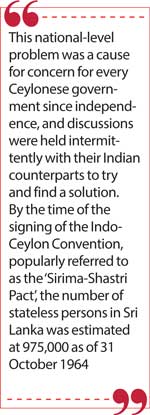 “This community was denied the privileges and access to public services and resources as the rest of the country for half a century. There’s a lot of catching up to do, and the minister and the government are committed to ensuring it.”
“This community was denied the privileges and access to public services and resources as the rest of the country for half a century. There’s a lot of catching up to do, and the minister and the government are committed to ensuring it.”
A history of citizenship concerns and enactments
However, despite the seemingly positive steps towards enfranchisement and empowerment being taken in modern times, it is important to record the chequered steps taken by successive Ceylonese governments vis-à-vis this long-marginalised community.
Initially, the Citizenship Act No. 18 of 1948 was enacted to provide for citizenship of Ceylon, and came into effect from 15 November 1948. Through the enactment of this law was established a legal status known as ‘being a citizen of Ceylon’ (Department of Immigration and Emigration, ‘Sri Lankan Identity Overseas: History of Immigration and Emigration and Citizenship of Sri Lanka’), which individuals concerned owned in one of two ways only – either by “right of descent as provided by the Act, or by virtue of registration as provided by the Act or by any other Act authorizing the granting of such status by registration.”
Immediately following this legislation, the Indian and Pakistani Citizenship Bill was passed in Sri Lanka’s Parliament to become the Indian and Pakistani (Citizenship) Bill No. 3 of 1949, which came into effect on 5 August of the same year. According to Section 5 of this law, persons eligible for citizenship under the Act had to apply for registration within two years from the appointed date. Later, that time period was extended up to three years.
 As the present-day Department of Immigration and Emigration of Sri Lanka observes: “The attitude of Ceylon towards the non-Ceylonese in the country who were genuinely desirous of merging with the Ceylonese is indicated in the provisions of this Act. For instance, under Section 3 of this Act, an Indian or Pakistani who could prove uninterrupted residence in Ceylon prior to 1 January 1946 – for 10 years in the case of unmarried persons, and seven years in the case of married persons – could apply for registration as a citizen and become registered, if they could prove lawful means of livelihood (Department of Immigration and Emigration, ‘Sri Lankan Identity Overseas: History of Immigration and Emigration and Citizenship of Sri Lanka’).
As the present-day Department of Immigration and Emigration of Sri Lanka observes: “The attitude of Ceylon towards the non-Ceylonese in the country who were genuinely desirous of merging with the Ceylonese is indicated in the provisions of this Act. For instance, under Section 3 of this Act, an Indian or Pakistani who could prove uninterrupted residence in Ceylon prior to 1 January 1946 – for 10 years in the case of unmarried persons, and seven years in the case of married persons – could apply for registration as a citizen and become registered, if they could prove lawful means of livelihood (Department of Immigration and Emigration, ‘Sri Lankan Identity Overseas: History of Immigration and Emigration and Citizenship of Sri Lanka’).
The time frame for applications to be considered under Act No. 3 of 1949 was three years. Meanwhile, according to Article 8 of the Indian Constitution, Indian-origin persons residing outside India on the date of commencement of that country’s supreme law – i.e. 26 January 1950 – had to register at the Indian diplomatic mission in the country of their present residence to become an Indian citizen. In Sri Lanka, registration was done at the Indian High Commission’s offices in both Colombo and Kandy. But the relatively limited registration and processing facilities that were available at the time were inadequate to facilitate all the Indian-origin people – numbering in excess of 1,000,000 persons – who were living in Ceylon at the time.
Also, as a result of the short time span for making applications for Ceylonese citizenship under Act No. 3 of 1949, a vast majority of Indian- and Pakistani-origin citizens who failed to meet the stipulated deadline for applications had to await redress for their plight at an unspecified future date.
And, as a result, a substantial number of these Indian-origin people – especially a significant number of the total ‘stateless’ people comprising so-called ‘upcountry Tamils’ – remained in the island without citizenship in either Ceylon or India.
Between statehood and bureaucratic buck-passing
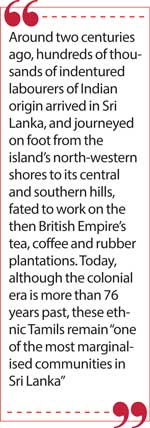 With the aim of addressing that issue, a conference was held between Ceylonese and Indian governmental representatives in New Delhi on 9 and 10 October 1954. The Ceylonese delegation opined that the so-called ‘stateless people’ continued to be Indian citizens until they were accepted – if at all – as citizens of Ceylon.
With the aim of addressing that issue, a conference was held between Ceylonese and Indian governmental representatives in New Delhi on 9 and 10 October 1954. The Ceylonese delegation opined that the so-called ‘stateless people’ continued to be Indian citizens until they were accepted – if at all – as citizens of Ceylon.
In effect, the government of Ceylon did not accept the position that these hapless individuals were in fact ‘stateless’. The Indian delegation disagreed, and held fast to their opinion that only persons of Indian origin who had been registered under Article 8 of the Indian Constitution and/or possessed passports or passes duly authorised by the Government of India were citizens of that country.
Eventually, the two nations came to an agreement. The Ceylonese delegation agreed to complete the processing of pending applications under Act No. 3 of 1949 within two years. The Indian delegation agreed to accommodate the registration of Indian-origin people resident in Ceylon as Indian citizens if they so wished under their Article No. 8.
The agreement between the two governments was known as the ‘Nehru-Kotelawala Pact’. But even this bilateral treaty did not solve the problem completely, as a large number of Indian-origin people remained in Sri Lanka without official belonging to either nation. In fact, only 134,329 Indian and Pakistani residents were issued with Ceylon citizenship certificates under the provisions of Act No. 3 of 1949, and therefore continued to be stateless.
This was their ongoing plight, and ultimately paved the path to another agreement, namely the ‘Sirima-Shastri Pact’ of a decade later, in 1964.
In addition to indentured labour brought in by the British to work on their plantations, there were literally hundreds of thousands of illegal aliens who entered Ceylon before its independence. The number of Indians who freely entered Ceylon under British rule – including those who did so illicitly and merged with the locals – amounted to at least “a couple of hundred thousand”, according to the imprecise estimates of the Sri Lankan Department of Immigration and Emigration.
This national-level problem was a cause for concern for every Ceylonese government since independence, and discussions were held intermittently with their Indian counterparts to try and find a solution. By the time of the signing of the Indo-Ceylon Convention, popularly referred to as the ‘Sirima-Shastri Pact’, the number of stateless persons in Sri Lanka was estimated at 975,000 as of 31 October 1964.
A bilateral agreement was entered into between the governments of Ceylon and India to grant Ceylonese citizenship to 300,000 persons and Indian citizenship to 525,000 people. An additional 150,000 individuals were accommodated as regards citizenship by and between the two sovereign nations concerned, bringing the newly declared Ceylonese citizen tally to 375,000 and the corresponding Indian number to 675,000.
Later, action was also taken by and between India and Ceylon to address the ongoing issue of statelessness, through the latter enacting the Indo-Ceylon Agreement (Implementation) Act No. 14 of 1967. For this, The Head of the Department for Registration of Immigration and Emigration was appointed as the Commissioner for Registration of Persons of Indian Origin.
Even though India agreed to grant Indian citizenship to some 600,000 persons, only a little over 500,000 individuals applied; and therefore, Ceylon had to accept to grant Ceylonese citizenship to just under 95,000 persons who would otherwise have been left stateless.
This took place much later, by enacting the provisions of the Grant of Citizenship to Stateless Persons Act No. 5 of 1986. And that brought the total number of individuals granted Ceylonese citizenship up to some 469,000 while the corresponding Indian citizenship number was around 506,000.
[To be continued]
| Editor-at-large of LMD | Many peoples. One nation. #PluralisticSriLanka |